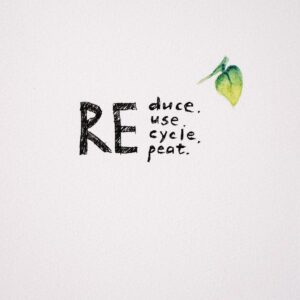In an age where climate change, biodiversity loss, and plastic pollution are urgent global concerns, adopting sustainable practices in our homes is no longer optional—it’s a responsibility. And there’s no better place to start than the kitchen.
The kitchen is often the largest contributor to household waste, producing everything from food scraps to single-use plastics, packaging, and harsh chemical cleaners. But with intentional planning, you can transform your kitchen into a zero-waste zone that aligns with eco-conscious living while saving money and reducing your carbon footprint.
This in-depth guide will walk you through practical steps, systems, and tools to create and maintain a zero-waste kitchen—no perfection needed, just progress.
What Does “Zero-Waste” Really Mean?
Zero-waste is a philosophy and lifestyle aimed at redesigning resource life cycles so that all products are reused, and no trash is sent to landfills, incinerators, or the ocean. It’s grounded in the 5Rs of Zero Waste:
- Refuse what you do not need
- Reduce what you do use
- Reuse what you can
- Recycle what you can’t reuse
- Rot (compost) the rest
Creating a zero-waste kitchen involves systematically applying these principles to your shopping habits, cooking routines, storage methods, and cleaning practices.
Step 1: Conduct a Kitchen Waste Audit
Before diving into changes, take stock of what’s currently going to waste.
➤ How to Do a Waste Audit:
- Track what you throw away for 7 days using a log or waste journal.
- Categorize waste into food scraps, packaging, single-use plastics, paper products, glass/metal, and recyclables.
- Weigh or estimate the volume of waste in each category.
This data helps you pinpoint where the majority of waste originates and allows you to prioritize areas of improvement.
Step 2: Shop Mindfully and Buy in Bulk
A zero-waste kitchen starts at the store. Conventional supermarkets are filled with products wrapped in layers of plastic, paper, and cardboard. Break the cycle by shopping smarter.
How to Shop Zero-Waste:
- Bring your own containers, jars, and reusable cloth bags.
- Buy from bulk bins or package-free grocery stores.
- Shop local from farmers’ markets to reduce transport emissions and avoid packaging.
- Prioritize seasonal and unpackaged produce.
Where to Shop:
Buying in bulk not only reduces packaging but also cuts down food cost per unit.
Step 3: Reduce Food Waste Through Smart Planning
Food waste is one of the biggest contributors to household emissions. Globally, over 1 billion tons of food is wasted every year (UNEP 2021).
Steps to Reduce Food Waste:
- Meal plan every week based on what’s already in your pantry and fridge.
- Store food properly using breathable bags or glass containers to extend shelf life.
- Freeze leftovers or surplus produce before it goes bad.
- Learn to cook with scraps: carrot tops, broccoli stems, and onion skins can be used in stocks.
Helpful App:
- Too Good To Go helps save food from restaurants and stores that would otherwise go to waste.
Step 4: Compost Kitchen Waste
Composting is essential in a zero-waste kitchen. When organic waste ends up in landfills, it decomposes anaerobically, producing methane—a greenhouse gas over 25 times more potent than CO₂.
Types of Composting:
- Backyard composting for garden owners.
- Bokashi bins for indoor spaces and apartment living.
- Vermicomposting (worm composting) for smaller food waste volumes.
- Use municipal compost pick-up services if available.
Learn how:
Compost these:
- Vegetable and fruit scraps
- Coffee grounds and filters
- Eggshells
- Paper towels (unbleached)
Step 5: Switch to Sustainable Kitchen Tools
Most kitchen tools and accessories are designed for convenience, not sustainability. Plastic utensils, cling wraps, and non-stick cookware all contribute to long-term waste and environmental harm.
Eco-Friendly Alternatives:
| Conventional | Zero-Waste Swap |
|---|---|
| Plastic wrap | Beeswax wraps, silicone lids |
| Plastic zip bags | Reusable silicone bags (e.g., Stasher) |
| Paper towels | Cloth towels or “unpaper” towels |
| Teflon cookware | Cast iron, stainless steel, or ceramic cookware |
| Sponges | Compostable loofahs or Swedish dishcloths |
Buy from:
Step 6: Make or Buy Zero-Waste Cleaning Products
Conventional cleaners come in plastic bottles and contain harmful chemicals that pollute waterways and disrupt marine ecosystems.
DIY All-Purpose Cleaner:
- 1 cup white vinegar
- 1 cup water
- 10 drops of lemon essential oil or citrus peels (infuse for 7 days)
Other swaps:
- Use baking soda as a scrub
- Use castile soap for dishwashing
Refillable Options:
Step 7: Refuse Single-Use Items
Single-use items are the nemesis of zero waste. They are used once and pollute forever.
Eliminate These From Your Kitchen:
- Disposable cutlery and paper plates
- Plastic straws
- Aluminum foil and cling wrap
- Coffee pods and tea bags (yes, most contain plastic!)
Use These Instead:
- Stainless steel or bamboo cutlery
- Cloth napkin
- Refillable spice jars
Step 8: Reuse and Upcycle What You Already Have
Zero-waste living isn’t about buying more eco-friendly stuff—it’s about using what you already have in creative, circular ways.
Examples:
- Glass jars → spice containers, dry food storage, or DIY candles
- Citrus peels → vinegar infusions for natural cleaners
- Vegetable scraps → broth
- Coffee grounds → fertilizer or natural body scrub
Look around—what can you reuse, repurpose, or repair before buying?
Step 9: Involve the Family or Roommates
Zero waste is easier when the whole household is on board.
How to engage others:
- Create a kitchen waste chart and track progress weekly.
- Assign eco-friendly responsibilities (e.g., composting, bulk shopping).
- Celebrate milestones like “Plastic-Free Pantry” or “One Month No Food Waste.”
Final Thoughts: It’s a Lifestyle, Not a Trend
Going zero waste isn’t about perfection. It’s about being conscious of how our daily habits affect the planet and making consistent efforts to minimize harm. A zero-waste kitchen is a powerful step in that journey—and one that inspires others to follow.
Every peel composted, every reusable bag packed, and every plastic container avoided counts. Start small, stay consistent, and you’ll be amazed at how impactful your kitchen can be in the fight against waste and climate change.
References & Resources
- UNEP Food Waste Index Report (2021): https://www.unep.org/resources/report/unep-food-waste-index-report-2021
- EPA’s Guide to Composting at Home: https://www.epa.gov/recycle/composting-home
- Too Good To Go App: https://toogoodtogo.com/
- Litterless Bulk Finder: https://www.litterless.com/wheretoshop
- Zero Waste Home Bulk Locator: https://zerowastehome.com/
- Package Free Shop: https://packagefreeshop.com/
- Blueland Cleaning Products: https://www.blueland.com/


